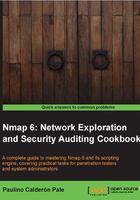
Discovering hosts with ICMP ping scans
Ping scans are used to determine if a host is online and responding. ICMP messages are used for this purpose, and hence ICMP ping scans use these types of packets to accomplish this.
The following recipe describes how to perform an ICMP ping scan with Nmap, and the flags for the different types of ICMP messages.
How to do it...
To make an ICMP echo request, open your terminal and enter the following command:
# nmap -sP -PE scanme.nmap.org
If the host responded, you should see something similar to this:
# nmap -sP -PE scanme.nmap.org Nmap scan report for scanme.nmap.org (74.207.244.221) Host is up (0.089s latency). Nmap done: 1 IP address (1 host up) scanned in 13.25 seconds
How it works...
The arguments -sP -PE scanme.nmap.org tell Nmap to send an ICMP echo request packet to the host scanme.nmap.org. We can determine that a host is online if we receive an ICMP echo reply to this probe.
SENT (0.0775s) ICMP 192.168.1.102 > 74.207.244.221 Echo request (type=8/code=0) ttl=56 id=58419 iplen=28 RCVD (0.1671s) ICMP 74.207.244.221 > 192.168.1.102 Echo reply (type=0/code=0) ttl=53 id=24879 iplen=28 Nmap scan report for scanme.nmap.org (74.207.244.221) Host is up (0.090s latency). Nmap done: 1 IP address (1 host up) scanned in 0.23 seconds
There's more...
Unfortunately, ICMP has been around for a pretty long time, and remote ICMP packets are now usually blocked by system administrators. However, it is still a useful ping technique for monitoring local networks.
See also
- The Finding live hosts in your network recipe in Chapter 1, Nmap Fundamentals
- The Discovering hosts with TCP SYN ping scans recipe
- The Discovering hosts with TCP ACK ping scans recipe
- The Discovering hosts with UDP ping scans recipe
- The Discovering hosts with IP protocol ping scans recipe
- The Discovering hosts with ARP ping scans recipe
- The Discovering hosts using broadcast pings recipe
- The Discovering stateful firewalls by using a TCP ACK scan recipe in Chapter 3, Gathering Additional Host Information